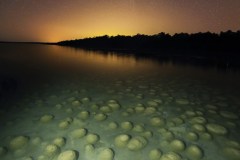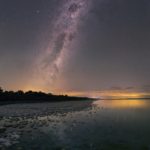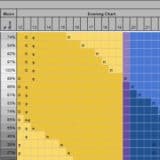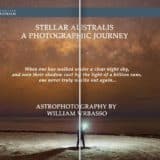Lake Clifton
by admin · January 17, 2018

Location Details
Scroll to bottom of page for images and posts
Lake Clifton is located in the Peel region of Western Australia just off the Old Coast Road, between Mandurah and Bunbury. It falls within the Yalgorup National Park, and its biggest draw card is the extensive rock-like structures called Thrombolites that thrive on the eastern shore. These structures are built by micro-organisms in the shallows at the waters edge by the trapping and cementing of sedimentation. Apparently, these microbes resemble some of the earliest known forms of life on Earth – although the thromobolites at Lake Clifton are relatively young in formation. There are only a few places in the world that thromobolites exist which makes Lake Clifton a very special lake indeed.
Summary Info
CATEGORY: Lake
RATING: Good
ACCESS: 2wd, sealed roads.
FEATURES: Lake, jetty and Thrombolites!!!.
CONSTRAINTS: Town to the east, but good views south and west. Some minor light pollution.
SUMMARY: Best viewed when Milkyway is in the western part of the sky. Return occassionally, as water levels reveal more Thrombolites when low. Popular with nightscapers. Small parking area, and even has toilets.
Google Maps
From Perth, travelling to Lake Clifton is a fairly easy 1.5 hour drive down the Kwinana Freeway past Mandurah before taking the Lake Clifton Rd exit and onto the Old Coast Rd. The road is sealed all the way and easy access to 2wd vehicles. There are a number of ways to get to Lake Clifton so check it up on Google Maps. A small car park exists in walking distance to the lake, and even includes a toilet facility (non-flushing) and park bench.
From the car park is a short walk along a sealed trail that cuts through the bush, leading to a wooding observation “jetty” that goes a bit out from the shore of the lake. There is another bush walk trail that goes through the bush a little way away from the shore (such that you can’t see the lake from the trail). I’ve only walked a little bit along this trail and don’t know its full extent – I don’t believe any good nightscape photo locations would be present on this trail. At the car park is an information board and map for those interested in the lake and surrounding trails.
From the jetty one can look down into the lake either south or north to view the wonderful dome like structures of the thrombolites – either revealed fully when the water is low, or fully immersed when it is not. The best time is when they are partly covered such that the waters of the lake flow between the domes, but does not cover them up. As such, timing or predicting the level of the water in the lake is advised – although difficult. I’ve noticed that the colour and transparency of the water varies a little – from muddy brown to a bluish hue (in some photos, but not mine). So best to ask around to see if anyone has visited recently, or just go back a number of times throughout the year.
Views of the lake are south, west, and north. The jetty heads off shore in a westerly direction, and the shore is aligned north to south. In summer time one can shoot to the south, capturing the thromobolites along the shore. During winter and spring months one can wait until the Milkyway core is in the western sky to shoot arching panoramas featuring the lake, jetty, and the thrombolites either side. However, one is prohibited from leaving the walkway or jetty which limits the number of compositions possible from this location. Also, during the Milkyway season the spot is quite popular with night photographers and can get “crowded” – not necessarily a bad thing but has the added complication of scheduling your shots with other people.
There is some light pollution in the night skies in the lake’s region, but the skies above are mostly dark. Views to the western horizon are relatively free of light pollution (although in one of my trips car headlights from the opposing shore did light up the sky there for periods of time). North, south and west suffer a little from town lights, but it isn’t bad and certainly shouldn’t dissuade anyone from trying nightscape shots from this great location.
A word of warning. The short walkway from the car park to the jetty is a favourite space for the local spiders to spin their webs across at night time. I’ve come close to being wrapped in their thin webs – and the spiders aren’t small either. I’ve gotten around this by picking up a long stick before heading out to the jetty and using it to batter down the webs on the way back.
Posts of Location




















